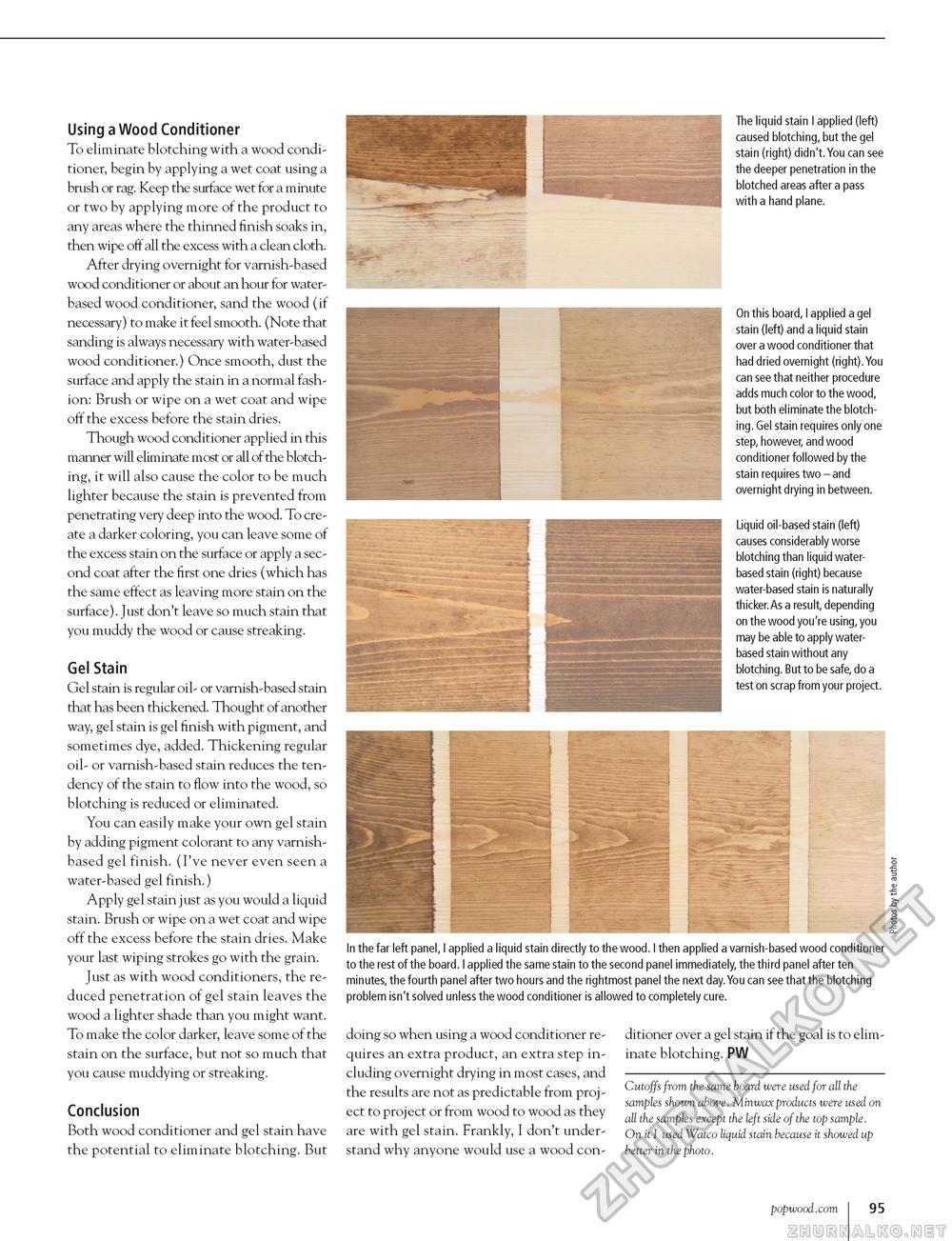Popular Woodworking 2004-04 № 140, страница 98
The liquid stain I applied (left) caused blotching, but the gel stain (right) didn't.You can see the deeper penetration in the blotched areas after a pass with a hand plane. On this board, I applied a gel stain (left) and a liquid stain over a wood conditioner that had dried overnight (right).You can see that neither procedure adds much color to the wood, but both eliminate the blotching. Gel stain requires only one step, however, and wood conditioner followed by the stain requires two - and overnight drying in between. Liquid oil-based stain (left) causes considerably worse blotching than liquid water-based stain (right) because water-based stain is naturally thicker.As a result, depending on the wood you're using, you may be able to apply water-based stain without any blotching. But to be safe, do a test on scrap from your project. In the far left panel, I applied a liquid stain directly to the wood. I then applied a varnish-based wood conditioner to the rest of the board. I applied the same stain to the second panel immediately, the third panel after ten minutes, the fourth panel after two hours and the rightmost panel the next day.You can see that the blotching problem isn't solved unless the wood conditioner is allowed to completely cure. Using a Wood Conditioner To eliminate blotching with a wood conditioner, begin by applying a wet coat using a brush or rag. Keep the surface wet for a minute or two by applying more of the product to any areas where the thinned finish soaks in, then wipe off all the excess with a clean cloth. After drying overnight for varnish-based wood conditioner or about an hour for water-based wood conditioner, sand the wood (if necessary) to make it feel smooth. (Note that sanding is always necessary with water-based wood conditioner.) Once smooth, dust the surface and apply the stain in a normal fashion: Brush or wipe on a wet coat and wipe off the excess before the stain dries. Though wood conditioner applied in this manner will eliminate most or all of the blotching, it will also cause the color to be much lighter because the stain is prevented from penetrating very deep into the wood. To create a darker coloring, you can leave some of the excess stain on the surface or apply a second coat after the first one dries (which has the same effect as leaving more stain on the surface). Just don't leave so much stain that you muddy the wood or cause streaking. Gel Stain Gel stain is regular oil- or varnish-based stain that has been thickened. Thought of another way, gel stain is gel finish with pigment, and sometimes dye, added. Thickening regular oil- or varnish-based stain reduces the tendency of the stain to flow into the wood, so blotching is reduced or eliminated. You can easily make your own gel stain by adding pigment colorant to any varnish-based gel finish. (I've never even seen a water-based gel finish.) Apply gel stain just as you would a liquid stain. Brush or wipe on a wet coat and wipe off the excess before the stain dries. Make your last wiping strokes go with the grain. Just as with wood conditioners, the reduced penetration of gel stain leaves the wood a lighter shade than you might want. To make the color darker, leave some of the stain on the surface, but not so much that you cause muddying or streaking. Conclusion Both wood conditioner and gel stain have the potential to eliminate blotching. But doing so when using a wood conditioner requires an extra product, an extra step including overnight drying in most cases, and the results are not as predictable from project to project or from wood to wood as they are with gel stain. Frankly, I don't understand why anyone would use a wood con- ditioner over a gel stain if the goal is to eliminate blotching. PW Cutoffs from the same board were used for all the samples shown above. Minwax products were used on all the samples except the left side of the top sample. On it I used Watco liquid stain because it showed up better in the photo. popwood.com 95 |








